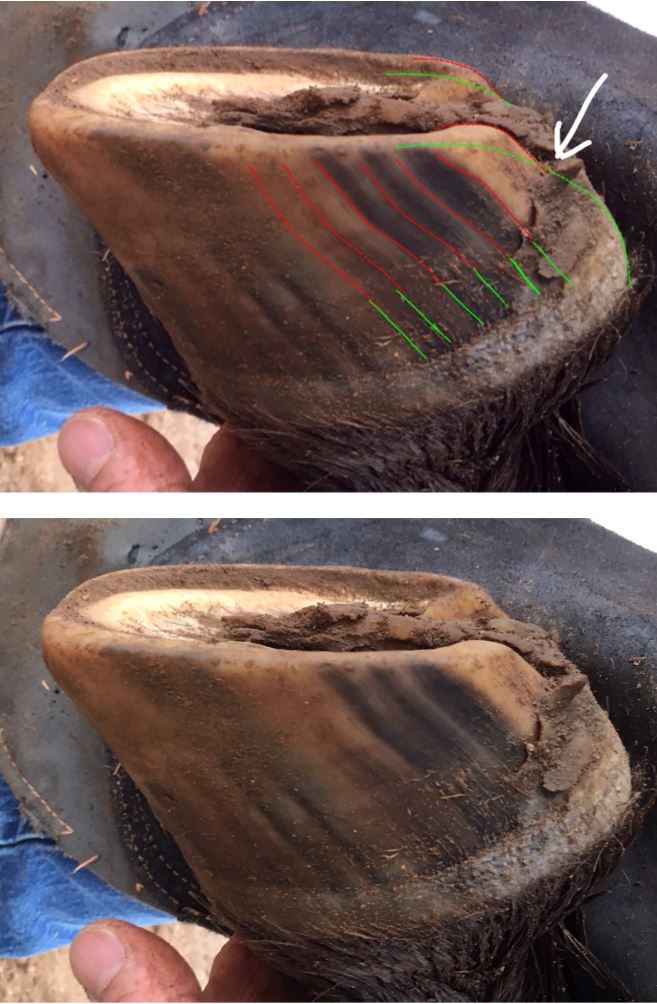Submitted by David Landreville of Landreville Hoof Care
This article is a continuation of my previous article, Rounding The Corner. The following photo collage is a good example of how I encourage a lower heel on a high heeled horse. These are two slightly different views of a before and after trim on a small pony with very tall heels. He grows this much heel in 3-4 weeks. I’ve been trimming Rio for over two years now. He used to have tall hoof capsules with a lot of retained dead and woody tissue. The owner and I have worked as a team to make the following changes:
~diet (Bermuda grass hay only)
~increased movement (owner designed and built a small track system for Rio and two other herd mates)
~footing (track system is in a desert area with sandy loam footing and the owner mucks regularly)
~frequent meticulous trimming (owner calls me at 3 weeks like clock work.)
The heels may still be too tall for this pony or they may come down some more, however, they are fully alive and supple (dead woody tissue gets removed at each trim interval leaving thick, supple, healthy tissue. This is an important distinction between a hoof that is unhealthy due to the heels being too high, depriving the regenerative caudal structures of the stimulation that is needed for continual development, and a hoof that is healthy and normal for the horse’s individual conformation. I refer to this as “bringing the life into a foot.”
Here are my personal heel trimming parameters as illustrated (fairly well) in these photos:
(In other words, I’m not telling anyone how to trim, I’m just showing how I trim.)

~lower and bevel the heel wall very close to the seat of corn around its entirety, being careful not to take them lower than LIVE frog tissue. This step can be confusing when there is an excess of dead retained sole at the seat of corn. In my experience, dead sole is retained where there is thin live sole. In these cases, I gauge the depth of each collateral groove and carefully try to achieve the same measurement on each heel without invading live sole or causing unbalanced pressure to the frog bulbs. For more information read Chapter 19, in “Heel Height: The Deciding Factor, Care and Rehabilitation, of the Equine Foot.”
~remove dead frog tissue
~smooth and round all surfaces to simulate wear for comfort and precise weight distribution.
In the before trim photos, there is a noticeable “re-curve” in the transition from soft heel bulbs to hard heel horn. I refer to this in the above mentioned blog. My immediate heel trimming goal is to get as much of the re-curve out so there is a single curve from the heel bulbs to the heels without compromising comfort or movement, which would be counter productive. To me, this only makes functional, anatomical, and humane sense. I try to never invade LIVE sole or LIVE frog because my long range trimming goal is to build these structures. I do come as close as I can though, depending on the footing that the horse lives on and the stage of development of the foot.
This pony rockets around his track system constantly developing better feet. He used to be edgy, timid, and bracey when being handled. In my experience, these are all signs of constant stress from the following CHRONIC conditions:
~tendon/ligament strain (throughout the entire body)
~joint misalignment (throughout the entire body)
~muscle strain (throughout the entire body)
~crushing of the hoof’s solar and coronary coriums
~tearing of the hoof’s dorsal lamellar connection

(Above) White arrow points to the apex of the recurve from Rounding the Corner (part 1)
Heels can be trimmed with the intention of achieving preconceived, desired angles which only last for a short time due to the hoof wall’s rapid growth rate (1/16″ every 4-5 days). Or heels can be trimmed with the intention of enhancing stimulation in order to increase blood flow and subsequent soft tissue development. The latter method is regenerative and requires frequent attention, and allows each horse the ability to evolve their individual true angles over time.
Get more information and keep up with what David is doing through the following links:





